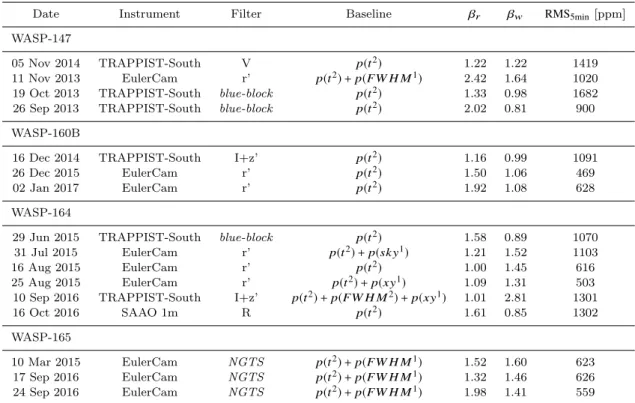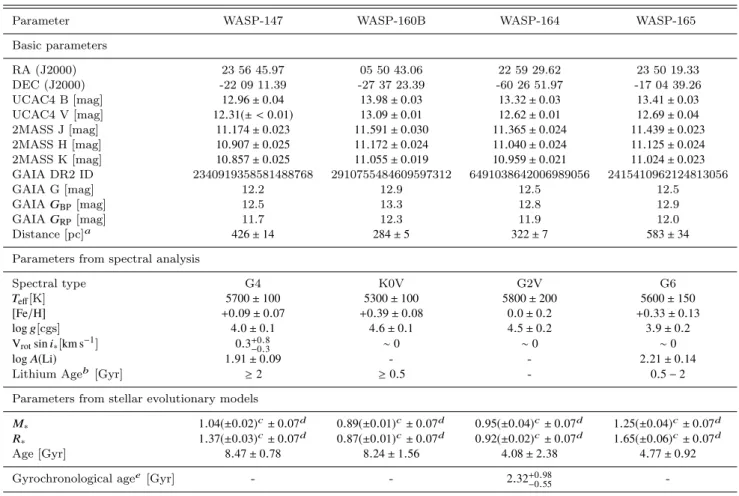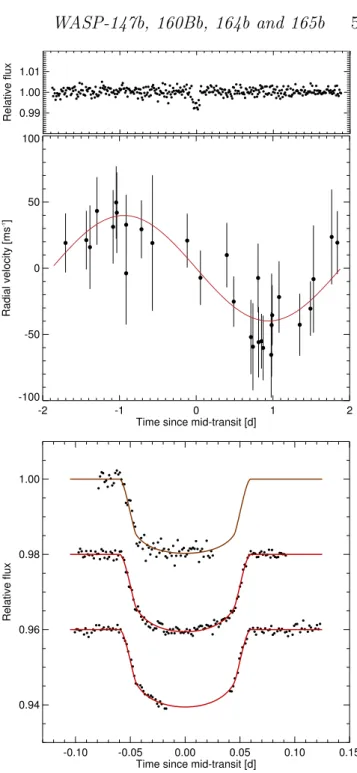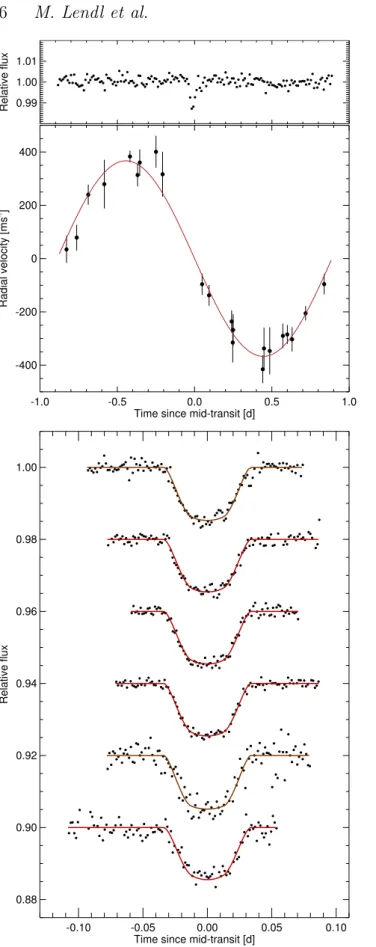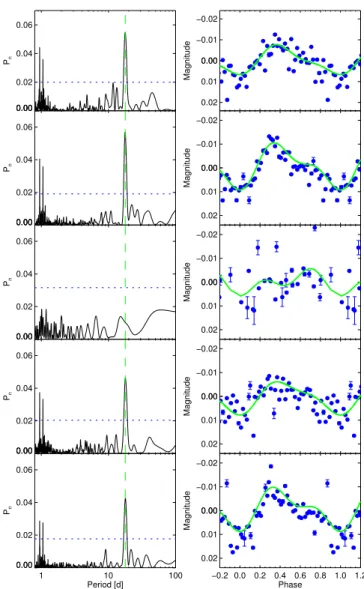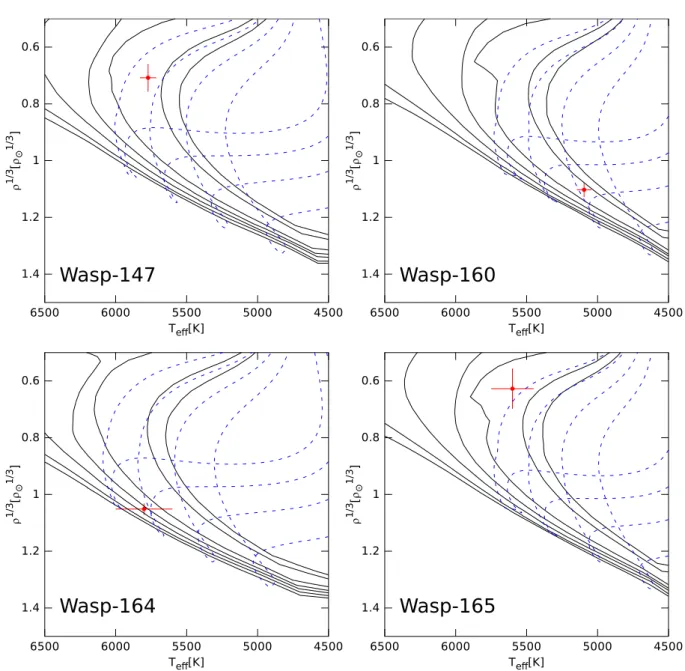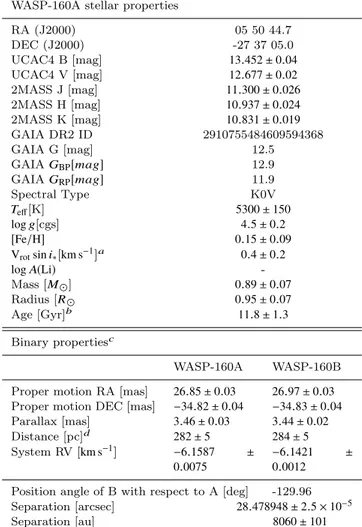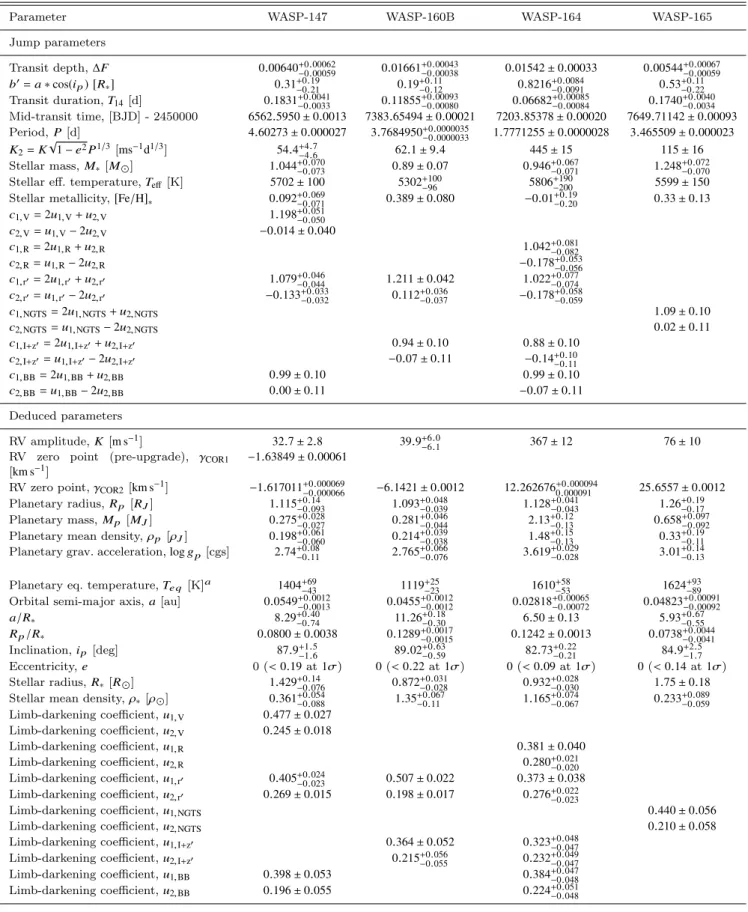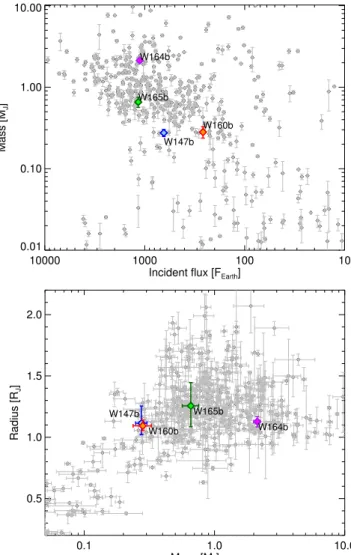WASP-147b, 160Bb, 164b and 165b: two hot Saturns and
two Jupiters, including two planets with metal-rich hosts
M. Lendl
1,2
?
, D.R. Anderson
3
, A. Bonfanti
4
, F. Bouchy
2
, A. Burdanov
4
,
A. Collier Cameron
5
, L. Delrez
6,4
, M. Gillon
4
, C. Hellier
3
, E. Jehin
4
,
P.F.L. Maxted
3
, L. Dyregaard Nielsen
2
, F. Pepe
2
, D. Pollacco
7
, D. Queloz
2,6
,
D. S´
egransan
2
, J. Southworth
3
, B. Smalley
3
, S. Thompson
6
, O. Turner
2
,
A.H.M.J. Triaud
8
, S. Udry
2
, and R.G. West
7
1Space Research Institute, Austrian Academy of Sciences, Schmiedlstr. 6, 8042 Graz, Austria
2Observatoire de Gen`eve, Universit´e de Gen`eve, Chemin des maillettes 51, 1290 Sauverny, Switzerland 3Astrophysics Group, Keele University, Staffordshire, ST5 5BG, UK
4Space sciences, Technologies and Astrophysics Research (STAR) Institute, Universit´e de Li`ege, All´ee du 6 Aoˆut 17, 4000 Li`ege, Belgium 5SUPA, School of Physics and Astronomy, University of St. Andrews, North Haugh, Fife, KY16 9SS, UK
6Cavendish Laboratory, J J Thomson Avenue, Cambridge, CB3 0HE, UK
7Department of Physics, University of Warwick, Gibbet Hill Road, Coventry CV4 7AL, UK
8School of Physics & Astronomy, University of Birmingham, Edgbaston, Birmingham B15 2TT, UK
Accepted XXX. Received YYY; in original form ZZZ
ABSTRACT
We report the discovery of four transiting hot Jupiters, WASP-147, WASP-160B, WASP-164 and WASP-165 from the WASP survey. WASP-147b is a near Saturn-mass (MP= 0.28MJ) object with a radius of 1.11 RJorbiting a G4 star with a period of 4.6 d.
WASP-160Bb has a mass and radius (Mp = 0.28 MJ, Rp = 1.09 RJ) near-identical to WASP-147b, but is less irradiated, orbiting a metal-rich K0 star with a period of 3.8 d. WASP-160B is part of a near equal-mass visual binary with an on-sky separation of 28.5 arcsec. WASP-164b is a more massive (MP= 2.13 MJ, Rp = 1.13 RJ) hot Jupiter,
orbiting a G2 star on a close-in (P = 1.8 d), but tidally stable orbit. WASP-165b is a classical (Mp = 0.66 MJ, RP = 1.26 RJ) hot Jupiter in a 3.5 d period orbit around
a metal-rich star. WASP-160B and WASP-165 are two of the most metal-rich stars ([Fe/H]∗ = 0.389 ± 0.080 and 0.33 ± 0.13, respectively) known to host a transiting
hot Jupiter. WASP-147b and WASP-160Bb are promising targets for atmospheric characterization through transmission spectroscopy, while WASP-164b presents a good target for emission spectroscopy.
Key words: keyword1 – keyword2 – keyword3
1 INTRODUCTION
Transiting exoplanets are invaluable objects for study. Not only are both, their masses and radii known, but also their transiting configuration opens up a wide range of character-ization avenues. We may study the atmospheres of these
ob-jects through their transmission and emission spectra (
Sea-ger & Sasselov 2000; Charbonneau et al. 2002,2005), but
also measure their orbital alignment (Queloz et al. 2000);
seeTriaud(2017) for a summary. While over 2700 transiting
? E-mail: monika.lendl@oeaw.ac.at
planets are known to date1, only a fraction of these objects are suitable for detailed characterization, as this requires the planet host to be bright and the star/planet size ratio to be favorable.
Ground based transit surveys (e.g. WASP, Pollacco
et al. 2006; HAT, Bakos et al. 2004; KELT, Pepper et al.
2007; and MASCARA,Talens et al. 2017) use small-aperture
instrumentation to monitor vast numbers of bright stars across nearly the entire sky, sensitive to the ∼ 1% dips cre-ated by transits of close-in giant planets. These hot Jupiters
1 according to exoplanets.eu, queried on 12 Apr 2018.
are prime targets for further characterization thanks to their large radii, frequent transits and extended atmospheres. In-deed, ground-based transit surveys have provided some of the most intensely studied planets to date (e.g. WASP-12b,
Hebb et al. 2009; WASP-43b,Hellier et al. 2011and
HAT-P-11b,Bakos et al. 2010).
In this paper, we report the discovery of four addi-tional close-in transiting gas giants by WASP-South, the two Saturn-mass planets WASP-147b and WASP-160Bb, and the two hot Jupiters WASP-164b and WASP-165b. We dis-cuss the observations leading to these discoveries in Section 2, describe their host stars in Section3and discuss the indi-vidual planetary systems and their place among the known
planet population in Section4before concluding in Section
5.
2 OBSERVATIONS
WASP-147 (2MASS 23564597-2209113), WASP-160B
(2MASS 05504305-2737233), WASP-164 (2MASS 22592962-6026519) and WASP-165 (2MASS 23501932-1704392) were monitored with the WASP-South facility throughout several years between 2006 and 2013. In the case of WASP-160B, the target flux was blended with that of another object (2MASS 05504470-2737050, revealing to be physically asso-ciated, see below) in the WASP aperture. The WASP-South instrument consists of an array of 8 cameras equipped with 200mm f/8 Canon lenses on a single mount and is located at SAAO (South Africa). For details on observing strategy, data reduction and target selection, please refer toPollacco
et al.(2006) and Collier Cameron et al. (2007). Using the
algorithms described by Collier Cameron et al. (2006),
we identified periodic flux drops compatible with transits of close-in giant planets in the light curves of these four objects. We thus triggered spectroscopic and photometric follow-up observations to determine the nature of the observed dimmings.
2.1 Follow-up spectroscopy
We obtained spectroscopic observations of all four objects using the CORALIE echelle spectrograph at the 1.2m Euler-Swiss telescope at La Silla. From the spectra, we computed radial velocities (RVs) using the weighted cross-correlation method (Baranne et al. 1996;Pepe et al. 2002). In 2014, the CORALIE spectrograph was upgraded by replacing circular with octagonal fibers, leading to a shift in RV zero point be-tween observations obtained before and after the exchange. WASP-160B, 164 and 165 were observed only after the up-grade, resulting in a single homogeneous set of RVs for each object. WASP-147 was observed before and after the up-grade, making it necessary to include these observations as two separate data sets in our analysis. For each of the four objects in question, RV variations confirmed the presence of a planet orbiting at the period of the observed transits (see Figs.1–4). To exclude stellar activity as the origin of the observed RV variations, we verified that bisector spans and RVs are uncorrelated (Queloz et al. 2001; Pearson coeffi-cients are -0.19, -0.16, -0.24 and 0.06 for WASP-147, 160, 164 and 165, respectively). This is illustrated in Fig.5, where we plot bisector spans against RVs. As both stellar components
of the WASP-160AB system fell into the same WASP-South aperture, we could not a-priori exclude either of them as the origin of the observed transits. We thus obtained several spectra of WASP-160A, showing no evidence of any large-amplitude RV variability (see Fig.6).
2.2 Follow-up photometry
We obtained several high-precision transit light curves for each of our targets to obtain an improved measurement of the transit shape and depth. The facilities we used for this purpose were EulerCam at the 1.2m Euler-Swiss telescope
(Lendl et al. 2012), the 0.6m TRAPPIST-South telescope
(Gillon et al. 2011;Jehin et al. 2011), and the SAAO 1.0m
telescope. In all cases, we extracted light curves of the tran-sit events using relative aperture photometry, while itera-tively selecting reference stars and aperture sizes to mini-mize the final light curve RMS. Having an on-sky separation of 28.478948 ± 2.5 × 10−5 arcsec, both stellar components of the WASP-160 system were well-separated in these observa-tions, confirming the fainter star, WASP-160B as the origin of the transit feature. Details on all photometric follow-up observations are listed in Table1. The resulting light curves are shown in Figs.1–4.
3 STELLAR PARAMETERS
3.1 Spectral analysis
The individual CORALIE spectra for each star were co-added in order to provide a spectrum for analysis. Using
methods similar to those described byDoyle et al. (2013),
for each star we determined the effective temperature (Teff), surface gravity (log g), stellar metallicity ([Fe/H]), and pro-jected stellar rotational velocity (vrotsin i∗). In determining
vrotsin i∗ we assumed a macroturbulent velocity using the
calibration given by (Doyle et al. 2014). For WASP-160B
and WASP-165 the vrotsin i∗ values are consistent with zero
and that of WASP-147 is close to an upper limit. If, however, a zero macroturbulent velocity is used, we obtain vrotsin i∗
values of 3.1 ± 0.5, 0.7 ± 0.6 and 2.8 ± 0.6 km s−1for WASP-147, WASP-160B and WASP-165, respectively.
The parameters for WASP-164 are relatively poorly de-termined, as the signal-to-noise ratio of the merged spectrum for WASP-164 is very low ( <∼ 20:1). The vrotsin i∗ is
consis-tent with zero, but very poorly determined and the Lithium 670.8 nm line might be present, but we cannot be sure due to the quality of the spectrum.
3.2 Rotation periods
The WASP light curves of WASP-164 show a quasi-periodic modulation with an amplitude of about 0.6 per cent and a period of about 18 days. We assume this is due to the com-bination of the star’s rotation and magnetic activity, i.e., star spots. We used the sine-wave fitting method described
inMaxted et al.(2011) to refine this estimate of the
ampli-tude and period of the modulation. Variability due to star spots is not expected to be coherent on long timescales as a consequence of the finite lifetime of star-spots and differen-tial rotation in the photosphere so we analyzed each season
Table 1. Summary of photometric follow-up observations together with the preferred baseline model, noise correction factors and the light curves’ RMS per 5 minute bin. The notation of the baseline models, p(ji), refers to a polynomial of degree i in parameter j. Filter
ranges:λblue−block> 500 nm, λNGTS= [500 − 900] nm,Wheatley et al.(2018).
Date Instrument Filter Baseline βr βw RMS5min[ppm]
WASP-147
05 Nov 2014 TRAPPIST-South V p(t2) 1.22 1.22 1419
11 Nov 2013 EulerCam r’ p(t2)+ p(FW H M1) 2.42 1.64 1020
19 Oct 2013 TRAPPIST-South blue-block p(t2) 1.33 0.98 1682
26 Sep 2013 TRAPPIST-South blue-block p(t2) 2.02 0.81 900
WASP-160B
16 Dec 2014 TRAPPIST-South I+z’ p(t2) 1.16 0.99 1091
26 Dec 2015 EulerCam r’ p(t2) 1.50 1.06 469
02 Jan 2017 EulerCam r’ p(t2) 1.92 1.08 628
WASP-164
29 Jun 2015 TRAPPIST-South blue-block p(t2) 1.58 0.89 1070
31 Jul 2015 EulerCam r’ p(t2)+ p(sky1) 1.21 1.52 1103
16 Aug 2015 EulerCam r’ p(t2) 1.00 1.45 616
25 Aug 2015 EulerCam r’ p(t2)+ p(xy1) 1.09 1.31 503
10 Sep 2016 TRAPPIST-South I+z’ p(t2)+ p(FW H M2)+ p(xy1) 1.01 2.81 1301
16 Oct 2016 SAAO 1m R p(t2) 1.61 0.85 1302
WASP-165
10 Mar 2015 EulerCam NGTS p(t2)+ p(FW H M1) 1.52 1.60 623
17 Sep 2016 EulerCam NGTS p(t2)+ p(FW H M1) 1.32 1.46 626
24 Sep 2016 EulerCam NGTS p(t2)+ p(FW H M1) 1.98 1.41 559
of data for WASP-164 separately. We also analyze the data from each camera used to observe WASP-164 separately so that we can assess the reliability of the results. We removed the transit signal from the data prior to calculating the pe-riodograms by subtracting a simple transit model from the light curve. We calculated periodograms over 8192 uniformly spaced frequencies from 0 to 1.5 cycles/day. The false alarm probability (FAP) is calculated using a boot-strap Monte
Carlo method also described in Maxted et al. (2011). The
results are given in Table3and the periodograms and light
curves for are shown in Fig.7. There is a clear signal near 17.8 days in 4 out of 5 data sets, from which we obtain a value for the rotation period of Prot = 17.81 ± 0.03 d. This
rotation period together with our estimate the stellar ra-dius implies a value of Vrotsin I = 2.6 ± 0.2 km s−1, assuming
that the rotation axis of the star is approximately aligned with the orbital axis of the planet. This is consistent with the low value for vrotsin i we obtain from our analysis of the
spectroscopy of WASP-164. We used a least-squares fit of a sinusoidal function and its first harmonic to model the ro-tational modulation in the light curves for each camera and season with the rotation period fixed at Prot= 17.81 d.
For WASP-147, WASP-160B and WASP-165 a similar analysis leads to upper limits of 1.2 millimagnitudes, 2.9 mil-limagnitudes and 1.2 milmil-limagnitudes with 95 per cent con-fidence for the amplitude of any sinusoidal signal over the same frequency range, respectively.
3.3 Stellar evolution modeling
In order to estimate stellar parameters, we considered Teff, [Fe/H], log g and v sin i inferred from spectral analysis (see Sec.3.1), the mean stellar densityρ?inferred from the
tran-sit light curve (see Sec.4.1) and magnitude G, color index
GB P−GR Pand distance d reported by Gaia DR2 (Gaia
Col-laboration et al. 2018). We analyzed 147 and
WASP-160B using the set G, GB P− GR P, d, [Fe/H], log g, ρ?and
vsin i as input parameters. For WASP-164 and WASP-165,
we adopted the same input set, but replaced the color in-dex by the spectroscopic temperature as it is more precisely known than that inferred from the Gaia colors. We recovered the main stellar parameters such as age, mass and radius according to theoretical models. We considered the grids of evolutionary tracks and isochrones computed by PAR-SEC2(version 1.2S; see Bressan et al. (2012); Chen et al. (2014) and references therein).
The interpolation of the input data in the theoretical grids to retrieve the output parameters has been done ac-cording to the isochrone placement technique described in
Bonfanti et al. (2015, 2016). Here we briefly recall that
the algorithm makes a comparison between observations and theoretical isochrones and select those theoretical data which match the observations best. In particular, for each star:
• multiple grids of isochrones spanning the input
metal-2 Padova and Trieste Stellar Evolutionary Code.
Table 2. Basic properties and stellar parameters of the planet hosts based on spectroscopic analysis, evolutionary models and photometric variability.aUsingGaia Collaboration et al.(2018) andStassun & Torres(2018);bUsingSestito & Randich(2005);cInternal model grid
uncertainty;dEstimated uncertainty accounting for different model grids;eUsingBarnes(2007).
Parameter WASP-147 WASP-160B WASP-164 WASP-165
Basic parameters RA (J2000) 23 56 45.97 05 50 43.06 22 59 29.62 23 50 19.33 DEC (J2000) -22 09 11.39 -27 37 23.39 -60 26 51.97 -17 04 39.26 UCAC4 B [mag] 12.96 ± 0.04 13.98 ± 0.03 13.32 ± 0.03 13.41 ± 0.03 UCAC4 V [mag] 12.31(± < 0.01) 13.09 ± 0.01 12.62 ± 0.01 12.69 ± 0.04 2MASS J [mag] 11.174 ± 0.023 11.591 ± 0.030 11.365 ± 0.024 11.439 ± 0.023 2MASS H [mag] 10.907 ± 0.025 11.172 ± 0.024 11.040 ± 0.024 11.125 ± 0.024 2MASS K [mag] 10.857 ± 0.025 11.055 ± 0.019 10.959 ± 0.021 11.024 ± 0.023 GAIA DR2 ID 2340919358581488768 2910755484609597312 6491038642006989056 2415410962124813056 GAIA G [mag] 12.2 12.9 12.5 12.5 GAIA GBP[mag] 12.5 13.3 12.8 12.9 GAIA GRP[mag] 11.7 12.3 11.9 12.0 Distance [pc]a 426 ± 14 284 ± 5 322 ± 7 583 ± 34
Parameters from spectral analysis
Spectral type G4 K0V G2V G6 Teff[K] 5700 ± 100 5300 ± 100 5800 ± 200 5600 ± 150 [Fe/H] +0.09 ± 0.07 +0.39 ± 0.08 0.0 ± 0.2 +0.33 ± 0.13 log g[cgs] 4.0 ± 0.1 4.6 ± 0.1 4.5 ± 0.2 3.9 ± 0.2 Vrotsin i∗[km s−1] 0.3+0.8−0.3 ∼ 0 ∼ 0 ∼ 0 log A(Li) 1.91 ± 0.09 - - 2.21 ± 0.14
Lithium Ageb [Gyr] ≥ 2 ≥ 0.5 - 0.5 − 2
Parameters from stellar evolutionary models
M∗ 1.04(±0.02)c± 0.07d 0.89(±0.01)c± 0.07d 0.95(±0.04)c± 0.07d 1.25(±0.04)c± 0.07d
R∗ 1.37(±0.03)c± 0.07d 0.87(±0.01)c± 0.07d 0.92(±0.02)c± 0.07d 1.65(±0.06)c± 0.07d
Age [Gyr] 8.47 ± 0.78 8.24 ± 1.56 4.08 ± 2.38 4.77 ± 0.92
Gyrochronological agee [Gyr] - - 2.32+0.98
−0.55
-Table 3. Periodogram analysis of the WASP light curves for WASP-164. Observing dates are JD-2450000, N is the number of observations used in the analysis, a is the semi-amplitude of the best-fit sine wave at the period P found in the periodogram with false-alarm probability FAP.
Camera Dates N P [d] a [mmag] FAP
221 5336-5515 7916 17.790 0.006 < 10−4
221 5699-5881 5623 17.730 0.007 < 10−4
221 6064-6106 1004 1.014 0.004 0.93 222 5352-5527 7906 17.850 0.006 < 10−4
222 5716-5897 5041 17.850 0.007 < 10−4
licity range [[Fe/H]−∆[Fe/H]; [Fe/H]+∆[Fe/H]] have been loaded;
• isochrones have been filtered through a 2-dimensional Gaussian window function whoseσ1= ∆Teff,σ2= ∆ log L;
• isochrones have been weighted evaluating the stellar evolutionary speed in the HR diagram and considering the similarity between theoretical and observational parameters;
• the gyrochronological relation by Barnes (2010) has
been used to set a conservative age lower limit to discard unlikely very young isochrones;
• element diffusion has been taken into account.
Uncertainties given by the code are simply internal, i.e. they are related to the interpolation scheme in use. Realistic uncertainties to be attributed to stellar parameters should take also theoretical model uncertainties into account. By comparing the results with two independent evolutionary
models (namely PARSEC and CLES3,Scuflaire et al. 2008),
we find that systematics due to models can be estimated to be ∼ 2%. In addition, helium content Y influences the-oretical models, but its quantity cannot be estimated from spectroscopy (at least in the case of solar-like stars). Given the uncertainty on Y , a further ∼ 5% should be added to the
error budget. Fig.8shows the placement of the planet hosts
in the HR diagram.
We also used the open source software bagemass4 to
calculate the posterior mass distribution for each star
us-ing the Bayesian method described byMaxted et al.(2015).
The models used in bagemass were calculated using the garstec stellar evolution code (Weiss & Schlattl 2008)
us-ing as input the spectroscopically-derived Teff and [Fe/H]
as well as the transit-derived ρ∗ and orbital Period. The
mass and age of the stars found are shown in Table 4.
They are in excellent agreement with the values derived above for WASP-147, 164 and 165. For WASP-160B,
bage-3 Code Li´egeois d’Evolution Stellaire 4 http://sourceforge.net/projects/bagemass
0.98 0.99 1.00 1.01 1.02 Relative flux -2 -1 0 1 2
Time since mid-transit [d] -100 -50 0 50 100 Radial velocity [ms -1] -0.15 -0.10 -0.05 -0.00 0.05 0.10 0.15 0.20 Time since mid-transit [d]
0.94 0.96 0.98 1.00
Relative flux
Figure 1. Discovery and follow-up photometry and RVs of WASP-147. Top panel: WASP survey data, phase-folded on the period of WASP-147b and binned per 15 minutes. Middle panel: CORALIE RV data, where the pre-upgrade data are shown as blue triangles, and the post-upgrade data are shown as black filled circles. Bottom panel: Follow-up transit light curves, corrected for their respective baseline models and binned by two minutes. They are (from top to bottom): V-band TRAPPIST data of 05 Nov 2014, and r’-band EulerCam data of 11 Nov 2013, and blue-block TRAPPIST data of 19 Oct 2013 and 26 Sep 2013.
0.99 1.00 1.01
Relative flux
-2 -1 0 1 2
Time since mid-transit [d] -100 -50 0 50 100 Radial velocity [ms -1] -0.10 -0.05 0.00 0.05 0.10 0.15 Time since mid-transit [d]
0.94 0.96 0.98 1.00
Relative flux
Figure 2. Discovery and follow-up photometry and RVs of WASP-160B. As Fig. 1. The light curves shown are (from top to bottom): I+z’-band TRAPPIST data of 16 Dec 2014, and r’-band EulerCam data of 26 Dec 2015 and 02 Jan 2017. Note that the transit depth in the WASP light curve is reduced due to con-tamination from WASP-160A.
mass favors a slightly younger age and higher mass. This is due to the input selection of bagemass that includes the spectroscopically-determined stellar effective tempera-ture instead of the Gaia color index.
3.4 The WASP-160 binary
Due to the low resolution of the WASP instrument, pho-tometry of WASP-160B was blended with a second, slightly
0.99 1.00 1.01
Relative flux
-1.0 -0.5 0.0 0.5 1.0
Time since mid-transit [d] -400 -200 0 200 400 Radial velocity [ms -1] -0.10 -0.05 0.00 0.05 0.10 Time since mid-transit [d]
0.88 0.90 0.92 0.94 0.96 0.98 1.00 Relative flux
Figure 3. Discovery and follow-up photometry and RVs of WASP-164. As Fig.1. The light curves shown are (from top to bottom): blue-block TRAPPIST data of 29 Jun 2015, r’-band Eu-lerCam data of 31 Jul 2015, 16 Aug 2015 and 25 Aug 2015, I+z’-band TRAPPIST data of 10 Sep 2016 and and R-I+z’-band SAAO data of 16 Oct 2016. 0.99 1.00 1.01 Relative flux -1 0 1
Time since mid-transit [d] -200 -100 0 100 200 Radial velocity [ms -1] -0.15 -0.10 -0.05 -0.00 0.05 0.10 0.15 Time since mid-transit [d]
0.97 0.98 0.99 1.00
Relative flux
Figure 4. Discovery and follow-up photometry and RVs of WASP-165. As Fig.1. The light curves shown are (from top to bottom): NGTS-filter EulerCam light curves of 10 Mar 2015, 17 Sep 2016 and 24 Sep 2016.
Table 4. Stellar mass and age estimates obtained with bagemass. The mean and standard deviation of the posterior distributions are given together with the best-fit values in parentheses.
Star Mass [M ] Age [Gyr]
WASP-147 1.08 ± 0.07 (1.05) 8.4 ± 1.9 (9.1) WASP-160B 0.98 ± 0.04 (1.01) 3.7 ± 2.3 (1.5) WASP-164 0.96 ± 0.07 (1.02) 4.7 ± 3.3 (2.0) WASP-165 1.17 ± 0.09 (1.18) 7.3 ± 2.2 (7.3)
-0.10 -0.05 0.00 0.05 0.10 Radial velocity [km/s] -0.10 -0.05 0.00 0.05 0.10 Bisector span [km/s] -0.10 -0.05 0.00 0.05 0.10 Radial velocity [km/s] -0.15 -0.10 -0.05 0.00 0.05 Bisector span [km/s] -0.4 -0.2 0.0 0.2 0.4 Radial velocity [km/s] -0.4 -0.2 0.0 0.2 0.4 Bisector span [km/s] -0.2 -0.1 0.0 0.1 0.2 Radial velocity [km/s] -0.2 -0.1 0.0 0.1 0.2 Bisector span [km/s] Wasp-147 Wasp-160 Wasp-164 Wasp-165
Figure 5. Bisector spans against RV of our targets. The RVs have been corrected for the systemic velocities given in Table6.
0 200 400 600 800 HJD - 2457000 -50 0 50 Radial velocity [ms -1]
Figure 6. CORALIE RVs of WASP-160A.
brighter, source. While exploratory RV observations and transit follow-up quickly identified the origin of the tran-sit the to be the fainter star, we found that both objects possess near-identical systemic RVs, pointing towards them being physically associated. This is confirmed by consistent Gaia proper motion and parallax values for both objects. To derive the properties of WASP-160A, we retrieved the stel-lar properties from a spectral analysis and stelstel-lar evolution
models as described in Section 3.1 and 3.3. For the
stel-lar evolution models, we used Gaia values for G, GB P− GR P and d, and results from our spectroscopic analysis for [Fe/H], log g, and v sin i as inputs. As we have not detected any tran-siting planet around WASP-160A, no transit-derived value
for ρ? was available. Our handful of RV measurements of
WASP-160A are stable within ∼40 m s−1. We summarize
the properties of WASP-160A and the WASP-160A+B
bi-nary in Table 5. Both stars appear to have similar masses
and early K spectral types and their projected separation of 28.478948 ± 2.5 × 10−5 arcsec translates into a physical dis-tance of 8060±101 au. Even though we would expect the two object to be coeval, we find a slightly older age for WASP-160A from evolutionary models. While this reinforces the older age estimate for WASP-160A, the discrepancy found
0.00 0.02 0.04 0.06 0.00 0.00 Pn −0.02 −0.01 0.00 0.01 0.02 0.00 Magnitude 0.00 0.02 0.04 0.06 0.00 0.00 Pn −0.02 −0.01 0.00 0.01 0.02 0.00 Magnitude 0.00 0.02 0.04 0.06 0.00 0.00 Pn −0.02 −0.01 0.00 0.01 0.02 0.00 Magnitude 0.00 0.02 0.04 0.06 0.00 0.00 Pn −0.02 −0.01 0.00 0.01 0.02 0.00 Magnitude 1 10 100 Period [d] 0.00 0.02 0.04 0.06 0.00 Pn −0.2 0.0 0.2 0.4 0.6 0.8 1.0 1.2 Phase −0.02 −0.01 0.00 0.01 0.02 0.00 Magnitude
Figure 7. Left: Periodograms of the WASP light curves for WASP-164. Horizontal lines indicate false-alarm probability lev-els 0.1, 0.01 and 0.001. Right: Light curves phase-binned on the assumed rotation period of 17.81 days (points) with second-order harmonic series fit by least squares (lines). Data are plotted by season and camera in the same order top-to-bottom as in Table3.
in our analysis between objects A and B is likely an artifact of the very limited available data on WASP-160A.
4 SYSTEM PARAMETERS
4.1 Modeling approach
We carried out a global analysis of all follow-up photometry and RVs for each planetary system using the Markov Chain
Monte Carlo (MCMC) framework described byGillon, M.
et al. (2012). In short, our model consists of a Keplerian
for the RVs and the prescription ofMandel & Agol(2002) for transit light curves. Next to the fitted (“jump”) param-eters listed in Table6, the code allows for the inclusion of parametric baseline models in the form of polynomials (up to 4th order) when fitting transit light curves. We tested
Wasp-147
Wasp-160
Wasp-164
Wasp-165
Figure 8. Placement of the planet host stars in the HR diagram. In each panel, theoretical models corresponding to the metallicity of that star are shown. Solid black lines are representative of isochrones: from left to right 0.5, 1, 2, 3.2, 5, 10 and 12.6 Gyr models are represented. Dashed blue lines are representative of evolutionary tracks: from left to right 1.1, 1, 0.9 and 0.8 M models are represented.
a wide range of baseline models, including dependencies on time, airmass, stellar FWHM, coordinate shifts and sky background, and finally selected the appropriate solution for
each light curve via Bayes factor comparison (e.g.Schwarz
1978). The best baseline models are listed in Table1. For all objects, we tested for a non-zero eccentricity by running two sets of global analyses: one while fixing the eccentricity to zero and one fitting for it by including√esin ω and√ecos ω as jump parameters. We found no significant evidence for a non-circular orbit for any of our targets.
To estimate excess noise, we calculated the βr and βw
(Winn et al. 2008;Gillon et al. 2010) factors that compare
the rms of the binned and unbinned residuals and multi-plied our error bars by their product before deriving the final parameter values. We find no excess “jitter” noise in the RVs and thus do not adapt the RV errors. We adopted a quadratic stellar limb-darkening law using coefficients
inter-polated from the tables byClaret & Bloemen(2011). To use the most appropriate input stellar parameters, we use the information extracted from the stellar spectra, paired with
the Gaia DR2 (Gaia Collaboration et al. 2018) data as
de-scribed in Section3. After carrying out an initial analysis to measure transit-based stellar mean densities needed to con-strain the evolutionary models, we placed normal priors on M∗, [Fe/H]∗ and Teff centered on the values inferred in
Sec-tion3, with a width of the quoted 1 − σ uncertainties. The
four objects under study are revealed to be gas giants, two of them being classical hot Jupiters, while two have masses near that of Saturn.
4.2 WASP-147
WASP-147b is a Saturn-mass (M= 0.27MJ) planet orbiting
Table 5. Properties of WASP-160A and the WASP-160A+B bi-naryaassuming a macroturbulence of 2.43km s−1fromDoyle et al.
(2014).bfrom stellar evolutionary models,cFrom Gaia DR2 and
CORALIE,d corrected usingStassun & Torres(2018).
WASP-160A stellar properties
RA (J2000) 05 50 44.7 DEC (J2000) -27 37 05.0 UCAC4 B [mag] 13.452 ± 0.04 UCAC4 V [mag] 12.677 ± 0.02 2MASS J [mag] 11.300 ± 0.026 2MASS H [mag] 10.937 ± 0.024 2MASS K [mag] 10.831 ± 0.019 GAIA DR2 ID 2910755484609594368 GAIA G [mag] 12.5 GAIA GBP[mag] 12.9 GAIA GRP[mag] 11.9 Spectral Type K0V Teff[K] 5300 ± 150 log g[cgs] 4.5 ± 0.2 [Fe/H] 0.15 ± 0.09 Vrotsin i∗[km s−1]a 0.4 ± 0.2 log A(Li) -Mass [M ] 0.89 ± 0.07 Radius [R 0.95 ± 0.07 Age [Gyr]b 11.8 ± 1.3 Binary propertiesc WASP-160A WASP-160B Proper motion RA [mas] 26.85 ± 0.03 26.97 ± 0.03 Proper motion DEC [mas] −34.82 ± 0.04 −34.83 ± 0.04 Parallax [mas] 3.46 ± 0.03 3.44 ± 0.02 Distance [pc]d 282 ± 5 284 ± 5 System RV [km s−1] −6.1587 ± 0.0075 −6.1421 ± 0.0012 Position angle of B with respect to A [deg] -129.96 Separation [arcsec] 28.478948 ± 2.5 × 10−5
Separation [au] 8060 ± 101
be old, with the 1.04 M host having started to evolve off the main sequence. Stellar evolutionary modeling places the star’s age at 8.5 ± 0.8 Gyr, and its old age is corroborated by a low Lithium abundance that is in accordance with mea-surements for stars aged 2 Gyrs or more (Sestito & Randich
2005) and the absence of activity indicators such as excess
RV stellar noise and rotational variability. The planet is one of the more strongly irradiated planets of its mass range.
Considering the mass – incident flux plane shown in Fig.9,
WASP-147b is located near the inner tip of the triangular sub-Saturn desert (Mazeh et al. 2005; Szab´o & Kiss 2011;
Mazeh et al. 2016), which appears to be created by erosion
of planetary atmospheres due to stellar irradiation (Baraffe
et al. 2006; Lammer et al. 2003). Being a mass,
low-density planet, WASP-147b is a good target for transmis-sion spectroscopy. One atmospheric scale height translates to a predicted change in the transit depth of 249 ppm, well within the precision of ground- and space-based transmis-sion spectra (e.g. Kreidberg et al. 2015; Sing et al. 2016;
Lendl et al. 2017;Sedaghati et al. 2017).
4.3 WASP-160B
Similar to WASP-147b, WASP-160Bb is also a near
Saturn-mass (Mp = 0.28MJ) object, however this planet orbits a
cooler K0V star in a wide (28.5 arcsec) near equal-mass bi-nary with a period of 3.8 days. Again, the stellar age is esti-mated to be approximately 8 Gyrs from evolutionary mod-els, and a non-detection of Lithium supports the object’s old age. In contrast to 147, the later-type WASP-160B still resides firmly on the main sequence. Both planets share near-identical mass and radius, however WASP-160b orbits one of the most metal-rich stars ([Fe/H]= 0.39 ± 0.08) known to host a transiting planet, while WASP-147’s metal-licity is near-Solar. WASP-160Bb receives less stellar
irra-diation than the bulk of hot Jupiters (see Fig. 9), which
translates to a moderate equilibrium temperature of 1100 K. Prospects for studying this object’s atmospheric transmis-sion spectrum are excellent, as one atmospheric scale height translates to a radius variation of 338 ppm. To date, the only hot Jupiter orbiting a more metal-rich host with a character-ized transmission spectrum is XO-2 (Burke et al. 2007;Sing
et al. 2011), for which both Na and K have been detected.
4.4 WASP-164
WASP-164b is a massive (Mp = 1.13MJ) planet on a
close-in orbit around a G2V star. Owclose-ing to the limited S/N of the follow-up spectra obtained, the stellar properties are somewhat more uncertain than for the other objects pre-sented here. However, rotational modulation with a period of 17.81 ± 0.03 days seen in the survey light curve indicates a relatively young age of 2.3+1−0.5Gyr and evolutionary mod-els confirm the star being located on the main sequence. The planet is rather massive compared to the bulk of hot Jupiters and orbits its host star with a short orbital period of 1.78 days at a separation of 2.74 times its Roche limit. This is consistent with expectations from high-eccentricity
migration mechanisms (Ford & Rasio 2006). Being rather
massive and close-in, the planet may be further undergoing orbital decay through tidal dissipation (e.g.Rasio et al. 1996;
Levrard et al. 2009;Matsumura et al. 2010). Using a value
of log Qs0 = 8.26 ± 0.14 (Collier Cameron & Jardine 2018), we find a remaining lifetime of 13.0 ± 4.6 Gyr. The plane-tary orbit is thus not expected to shrink drastically due to tidal dissipation over the star’s main-sequence lifetime. The planet’s close-in orbital period is however advantageous for the object’s atmospheric characterization. Indeed, WASP-164b makes for a promising target for characterization via emission spectroscopy, with a predicted occultation depth in H band between 450 ppm (full redistribution) and 1125 ppm (immediate reradiation).
4.5 WASP-165
WASP-165b is a classical hot Jupiter. With an orbital riod of 3.4 days, it lies near the peak of the hot Jupiter
pe-riod distribution while its mass (MP= 0.66MJ) and radius
(RP= 1.26RJ) are typical for this class of planet (see Fig.9). With respect to planetary mass, radius and period, WASP-165b is near-identical to the extremely well-studied object
HD 209458b (Mazeh et al. 2000;Charbonneau et al. 2000;
Table 6. Planetary and stellar parameters from a global MCMC analysis.
aEquilibrium temperature, assuming A
B= 0 and F = 1 (Seager et al. 2005).
Parameter WASP-147 WASP-160B WASP-164 WASP-165
Jump parameters Transit depth, ∆F 0.00640+0.00062−0.00059 0.01661+0.00043−0.00038 0.01542 ± 0.00033 0.00544+0.00067−0.00059 b0= a ∗ cos(i p) [R∗] 0.31+0.19−0.21 0.19+0.11−0.12 0.8216+0.0084−0.0091 0.53+0.11−0.22 Transit duration, T14[d] 0.1831+0.0041−0.0033 0.11855+0.00093−0.00080 0.06682+0.00085−0.00084 0.1740+0.0040−0.0034 Mid-transit time, [BJD] - 2450000 6562.5950 ± 0.0013 7383.65494 ± 0.00021 7203.85378 ± 0.00020 7649.71142 ± 0.00093 Period, P [d] 4.60273 ± 0.000027 3.7684950+0.0000035−0.0000033 1.7771255 ± 0.0000028 3.465509 ± 0.000023 K2= K √ 1 − e2P1/3[ms−1d1/3] 54.4+4.7 −4.6 62.1 ± 9.4 445 ± 15 115 ± 16 Stellar mass, M∗[M ] 1.044+0.070−0.073 0.89 ± 0.07 0.946+0.067−0.071 1.248+0.072−0.070
Stellar eff. temperature, Teff[K] 5702 ± 100 5302+100−96 5806+190−200 5599 ± 150
Stellar metallicity, [Fe/H]∗ 0.092+0.069−0.071 0.389 ± 0.080 −0.01+0.19−0.20 0.33 ± 0.13
c1,V= 2u1,V+ u2,V 1.198+0.051−0.050 c2,V= u1,V− 2u2,V −0.014 ± 0.040 c1,R= 2u1,R+ u2,R 1.042+0.081−0.082 c2,R= u1,R− 2u2,R −0.178+0.053−0.056 c1,r0= 2u1,r0+ u2,r0 1.079+0.046−0.044 1.211 ± 0.042 1.022+0.077−0.074 c2,r0= u1,r0− 2u2,r0 −0.133+0.033−0.032 0.112+0.036−0.037 −0.178+0.058−0.059 c1,NGTS= 2u1,NGTS+ u2,NGTS 1.09 ± 0.10 c2,NGTS= u1,NGTS− 2u2,NGTS 0.02 ± 0.11
c1,I+z0= 2u1,I+z0+ u2,I+z0 0.94 ± 0.10 0.88 ± 0.10 c2,I+z0= u1,I+z0− 2u2,I+z0 −0.07 ± 0.11 −0.14+0.10−0.11
c1,BB= 2u1,BB+ u2,BB 0.99 ± 0.10 0.99 ± 0.10
c2,BB= u1,BB− 2u2,BB 0.00 ± 0.11 −0.07 ± 0.11
Deduced parameters
RV amplitude, K [m s−1] 32.7 ± 2.8 39.9+6.0−6.1 367 ± 12 76 ± 10
RV zero point (pre-upgrade), γCOR1
[km s−1]
−1.63849 ± 0.00061
RV zero point,γCOR2[km s−1] −1.617011+0.000069−0.000066 −6.1421 ± 0.0012 12.262676+0.0000940.000091 25.6557 ± 0.0012
Planetary radius, Rp[RJ] 1.115+0.14−0.093 1.093+0.048−0.039 1.128+0.041−0.043 1.26+0.19−0.17
Planetary mass, Mp[MJ] 0.275+0.028−0.027 0.281+0.046−0.044 2.13+0.12−0.13 0.658+0.097−0.092
Planetary mean density,ρp [ρJ] 0.198+0.061−0.060 0.214+0.039−0.038 1.48+0.15−0.13 0.33+0.19−0.11
Planetary grav. acceleration, log gp[cgs] 2.74+0.08−0.11 2.765+0.066−0.076 3.619+0.029−0.028 3.01+0.14−0.13
Planetary eq. temperature, Te q [K]a 1404+69−43 1119+25−23 1610+58−53 1624+93−89
Orbital semi-major axis, a [au] 0.0549+0.0012−0.0013 0.0455+0.0012−0.0012 0.02818+0.00065−0.00072 0.04823+0.00091−0.00092
a/R∗ 8.29+0.40−0.74 11.26+0.18−0.30 6.50 ± 0.13 5.93+0.67−0.55
Rp/R∗ 0.0800 ± 0.0038 0.1289+0.0017−0.0015 0.1242 ± 0.0013 0.0738+0.0044−0.0041
Inclination, ip [deg] 87.9+1.5−1.6 89.02+0.63−0.59 82.73+0.22−0.21 84.9+2.5−1.7
Eccentricity, e 0 (< 0.19 at 1σ) 0 (< 0.22 at 1σ) 0 (< 0.09 at 1σ) 0 (< 0.14 at 1σ) Stellar radius, R∗[R ] 1.429+0.14−0.076 0.872+0.031−0.028 0.932+0.028−0.030 1.75 ± 0.18
Stellar mean density,ρ∗[ρ ] 0.361+0.054−0.088 1.35+0.067−0.11 1.165+0.074−0.067 0.233+0.089−0.059
Limb-darkening coefficient, u1,V 0.477 ± 0.027 Limb-darkening coefficient, u2,V 0.245 ± 0.018 Limb-darkening coefficient, u1,R 0.381 ± 0.040 Limb-darkening coefficient, u2,R 0.280+0.021−0.020 Limb-darkening coefficient, u1,r0 0.405+0.024−0.023 0.507 ± 0.022 0.373 ± 0.038 Limb-darkening coefficient, u2,r0 0.269 ± 0.015 0.198 ± 0.017 0.276+0.022−0.023 Limb-darkening coefficient, u1,NGTS 0.440 ± 0.056 Limb-darkening coefficient, u2,NGTS 0.210 ± 0.058
Limb-darkening coefficient, u1,I+z0 0.364 ± 0.052 0.323+0.048−0.047 Limb-darkening coefficient, u2,I+z0 0.215+0.056−0.055 0.232+0.049−0.047 Limb-darkening coefficient, u1,BB 0.398 ± 0.053 0.384+0.047−0.048
10000 1000 100 10 Incident flux [FEarth]
0.01 0.10 1.00 10.00 Mass [M J ] W147b W160b W164b W165b 0.1 1.0 10.0 Mass [MJ] 0.5 1.0 1.5 2.0 Radius [R J ] W147b W160b W164b W165b
Figure 9. Top: Planetary masses against incident flux for known exoplanets. Only planets with well-measured masses and radii (relative uncertainties smaller than 50%) are shown. Our newly-discovered objects are shown in color and labelled. Bottom: Plan-etary mass-radius diagram. Sample selection and designation of our targets as above.
irradiated as its M∗= 1.25M G6 host has started evolving
off the main sequence. The system’s age estimate from evo-lutionary models is 4.8 ± 1 Gyr, albeit the object’s Lithium abundance suggests a slightly younger age of 0.5 − 2 Gyr. This discrepancy is most likely due to the limited S/N of our spectra. We consider the age estimate from evolution-ary models as more accurate, as these contain the stellar mean density inferred from the high-precision follow-up light curves. As WASP-160B, also WASP-165 has a remarkably high metallicity of [Fe/H]= 0.33 ± 0.13.
5 SUMMARY
We present the discovery of four transiting hot Jupiters by WASP-South. WASP-147b and WASP-160Bb are Saturn-mass planets with near-identical radii but contrasting stel-lar metallicities and planetary equilibrium temperatures: the 1400 K WASP-147b orbits a Solar-metallicity G4 star, while
the 1100 K WASP-160Bb orbits a metal-rich K0 star in a near equal-mass binary. Both objects are promising tar-gets for atmospheric characterization via transmission spec-troscopy. WASP-164b is a massive (2.1 MJ) planet on a short
(1.8 d) orbital period, and a potential target for emission spectroscopy. Finally, WASP-165b is a classical hot Jupiter orbiting a metal-rich host.
ACKNOWLEDGEMENTS
WASP-South is hosted by the South African Astronomi-cal Observatory and we are grateful for their ongoing sup-port and assistance. Funding for WASP comes from consor-tium universities and from the UK’s Science and Technol-ogy Facilities Council. TRAPPIST is funded by the Belgian Fund for Scientific Research (Fond National de la Recherche Scientifique, FNRS) under the grant FRFC 2.5.594.09.F, with the participation of the Swiss National Science Fun-dation (SNF). L.D. acknowledges support from the Gruber Foundation Fellowship. M.L. acknowledges support from the Austrian Research Promotion Agency (FFG) under project 859724 ”GRAPPA”.
REFERENCES
Bakos G., Noyes R. W., Kov´acs G., Stanek K. Z., Sasselov D. D., Domsa I., 2004,PASP,116, 266
Bakos G. ´A., et al., 2010,ApJ,710, 1724
Baraffe I., Alibert Y., Chabrier G., Benz W., 2006,A&A,450, 1221
Baranne A., et al., 1996, A&AS,119, 373 Barnes S. A., 2007,ApJ,669, 1167 Barnes S. A., 2010,ApJ,722, 222
Bonfanti A., Ortolani S., Piotto G., Nascimbeni V., 2015,A&A, 575, A18
Bonfanti A., Ortolani S., Nascimbeni V., 2016,A&A,585, A5 Bressan A., Marigo P., Girardi L., Salasnich B., Dal Cero C.,
Rubele S., Nanni A., 2012,MNRAS,427, 127 Burke C. J., et al., 2007,ApJ,671, 2115
Charbonneau D., Brown T. M., Latham D. W., Mayor M., 2000, ApJ,529, L45
Charbonneau D., Brown T. M., Noyes R. W., Gilliland R. L., 2002,ApJ,568, 377
Charbonneau D., et al., 2005,ApJ,626, 523
Chen Y., Girardi L., Bressan A., Marigo P., Barbieri M., Kong X., 2014,MNRAS,444, 2525
Claret A., Bloemen S., 2011,A&A,529, A75
Collier Cameron A., Jardine M., 2018, preprint, (arXiv:1801.10561)
Collier Cameron A., et al., 2006,MNRAS,373, 799 Collier Cameron A., et al., 2007,MNRAS,380, 1230 Doyle A. P., et al., 2013,MNRAS,428, 3164
Doyle A. P., Davies G. R., Smalley B., Chaplin W. J., Elsworth Y., 2014,MNRAS,444, 3592
Ford E. B., Rasio F. A., 2006,ApJ,638, L45
Gaia Collaboration Brown A. G. A., Vallenari A., Prusti T., de Bruijne J. H. J., Babusiaux C., Bailer-Jones C. A. L., 2018, preprint, (arXiv:1804.09365)
Gillon, M. et al., 2012,A&A, 542, A4 Gillon M., et al., 2010,A&A,511, A3
Gillon M., Jehin E., Magain P., Chantry V., Hutsem´ekers D., Manfroid J., Queloz D., Udry S., 2011, Detection and Dy-namics of Transiting Exoplanets, St.˜Michel l’Observatoire,
France, Edited by F.˜Bouchy; R.˜D´ıaz; C.˜Moutou; EPJ Web of Conferences, Volume 11, id.06002,11, 6002
Hebb L., et al., 2009,ApJ,693, 1920 Hellier C., et al., 2011,A&A,535, L7
Henry G. W., Marcy G. W., Butler R. P., Vogt S. S., 2000,ApJ, 529, L41
Jehin E., et al., 2011, The Messenger,145, 2 Kreidberg L., et al., 2015,ApJ,814, 66
Lammer H., Selsis F., Ribas I., Guinan E. F., Bauer S. J., Weiss W. W., 2003,ApJ,598, L121
Lendl M., et al., 2012,A&A,544, A72
Lendl M., Cubillos P. E., Hagelberg J., M¨uller A., Juvan I., Fossati L., 2017, preprint, (arXiv:1708.05737)
Levrard B., Winisdoerffer C., Chabrier G., 2009,ApJ,692, L9 Mandel K., Agol E., 2002,ApJ,580, L171
Matsumura S., Peale S. J., Rasio F. A., 2010,ApJ,725, 1995 Maxted P. F. L., et al., 2011,PASP,123, 547
Maxted P. F. L., Serenelli A. M., Southworth J., 2015,A&A,575, A36
Mazeh T., et al., 2000,ApJ,532, L55
Mazeh T., Zucker S., Pont F., 2005,MNRAS,356, 955 Mazeh T., Holczer T., Faigler S., 2016,A&A,589, A75
Pepe F., Mayor M., Galland F., Naef D., Queloz D., Santos N. C., Udry S., Burnet M., 2002,A&A,388, 632
Pepper J., et al., 2007,PASP,119, 923 Pollacco D. L., et al., 2006,PASP,118, 1407
Queloz D., Eggenberger A., Mayor M., Perrier C., Beuzit J. L., Naef D., Sivan J. P., Udry S., 2000, A&A,359, L13
Queloz D., et al., 2001,A&A,379, 279
Rasio F. A., Tout C. A., Lubow S. H., Livio M., 1996,ApJ,470, 1187
Schwarz 1978, Annals of Statistics, 6, 461
Scuflaire R., Th´eado S., Montalb´an J., Miglio A., Bourge P.-O., Godart M., Thoul A., Noels A., 2008,Ap&SS,316, 83 Seager S., Sasselov D. D., 2000,ApJ,537, 916
Seager S., Richardson L. J., Hansen B. M. S., Menou K., Cho J. Y.-K., Deming D., 2005,ApJ,632, 1122
Sedaghati E., et al., 2017,Nature,549, 238 Sestito P., Randich S., 2005,A&A,442, 615 Sing D. K., et al., 2011,A&A,527, A73 Sing D. K., et al., 2016,Nature,529, 59
Stassun K. G., Torres G., 2018, preprint, (arXiv:1805.03526) Szab´o G. M., Kiss L. L., 2011,ApJ,727, L44
Talens G. J. J., Spronck J. F. P., Lesage A.-L., Otten G. P. P. L., Stuik R., Pollacco D., Snellen I. A. G., 2017,A&A,601, A11 Triaud A. H. M. J., 2017, The Rossiter–McLaughlin Effect in Exoplanet Research. p. 2,doi:10.1007/978-3-319-30648-3 2-1 Weiss A., Schlattl H., 2008,Ap&SS,316, 99
Wheatley P. J., et al., 2018,MNRAS,475, 4476 Winn J. N., et al., 2008,ApJ,683, 1076
This paper has been typeset from a TEX/LATEX file prepared by
